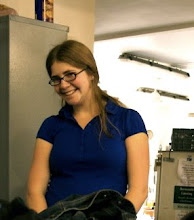Lida, Belarus, 2nd night of Pesach:
What does the salt water represent? Jewish tears.
What does maror represent? Jewish pain all through history.
These simple answers, given by Lena, a 16-year old with an incredible voice, were not mere parroting of history lessons. The history of Jewish tears and pain is real and current in Belarus, even for a teenaged girl. But just like the story of Exodus, in its retelling at our Pesach seder, the bitterness and tears turn to freedom, redemption, and joy by the end of our story.
Over the course of 4 days, I traveled to Minsk, Grodno, and Lida, leading seders in Progressive communities under the auspices of the FSU Pesach Project, a partnership between HUC and the World Union for Progressive Judaism. My partner Rayna and I sang and danced to Yiddish songs (including a Yiddish rendition of Dayenu!) with the elderly Jews of Grodno, had a surprise motorboat ride in a lake in Lida with Igor, and watched a cantorial festival, featuring costumes slightly reminiscent of the Sound of Music. We spent hours talking with our translator, Ilona, about growing up Jewish in Belarus, paying for school, boyfriends, languages, our own hopes for the future.
By far the most powerful day was the time we spent in Lida. After arriving by bus from Grodno and eating lunch, we met Igor, a community member, for a tour of the city and its Jewish sites. We stood in the parking lot of an apartment complex. Igor gestured around us, saying, "This used to be a Jewish cemetery." Were it not for the memorial by the Jewish community, no one would know. We drove a little bit out of the city proper, to a monument on the side of a road, across from a forest. This monument, Igor told us, marked the spot where all of Lida's Jewish children were killed on the day the Nazis liquidated its ghetto in the spring of 1942. Their parents were marched into the forest across the way.
Here, we didn't need a monument to see what had happened. Mounds of earth rose unnaturally from the ground in a forest clearing, now covered in grass and wildflowers. These were the mass graves, memorialized by a Soviet-era plaque to Lida's citizens, no mention of the reason they were killed - their Jewishness.
At seder, we pair the salt water of Jewish tears with karpas, the greenery symbolizing springtime, rebirth, and renewal. The seder was our karpas. We walked into the room, bustling with preparations. Lena sang the 4 Questions beautifully. We sang, ate, prayed, told stories, and asked questions. We applauded the children's choir, recently returned from a choral competition in MInsk. They proudly sang for their parents and community, without any hesitation or embarrassment. The children of Lida needed no prodding to make the connection between the ancient story of יציאת מצריים, the Exodus from Egypt, and our people's more recent history. In organizing, we speak of the story of self, the story of us, the story of now - how does my story relate to the story of my community, to my people, to what is happening in my world? The stories of our people's pain are the story of self for so many people.
Speaking of the story of us, after spending Pesach in Belarus I have a much deeper and more complex understanding of Jewish peoplehood. It means something different outside of Israel - I appreciate the presence of other Jews more. At seder on Monday night in Grodno, we were singing Oseh Shalom, and the words ועל כל ישראל, and on all Israel, made me tear up. I was so struck by feeling part of a collective with people who I had known for barely two hours - we had nothing in common, nothing bringing us to that little room together, save for our Jewishness and the commitment to tell the story of the Exodus.
I've noticed that when I see Jews outside of Israel, like the black hat, tzittzit twirling boys who were on all of our flights, I feel a warmth and kinship towards them that I don't feel in Israel when I see haredim (even though those boys would only speak to Ricky). Only in Belarus would the 2 rabbis of Minsk, Chabad and Progressive, stand next to each other at the airport while picking up their students, coming from Israel to lead seder.
As much as I loved the experience of leading seders with the welcoming communities in Belarus, of course I missed celebrating Pesach at home with my family. The traditions, the jokes, the days that Mom spends preparing food (especially matzah ball soup, which was missing from all of the seders!)...I shared this with Ilona, and she responded, "You're lucky. I've never done a seder Pesach with my family."
In b.Pesachim 116a, it says, "The haggadah started in disgrace and ended in praise." The praise here is not only for the Religious Union for Progressive Judaism in Belarus and the communities there, but for God. In the traditional text of the 2nd blessing of the Amidah, the גבורות, it says, ברוך אתה ה' מחיה המיתים - Blessed is God, who gives life to the dead. The revival and rebirth of Judaism in Belarus, the move from children's graves to children's choirs, is a vibrant example of the potential for rebirth and renewal in our broken world.
(And that Ferris wheel? We rode one in Minsk. It was awesome.)
The Absolute Best Burger Bowl with Potatoes
1 month ago




No comments:
Post a Comment